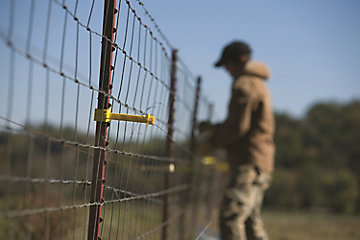How to Test an Electric Fence with a Multimete
Electric fences provide an effective solution for containing animals and protecting property. Whether you have livestock on a farm or want to safeguard your garden from unwanted intruders, an electric fence with multimeter can provide a reliable deterrent.
However, simply installing an electric fence is not enough. Regular testing is essential to ensure its safety and effectiveness.
In this article, we will guide you through the process of testing an electric fence using a multimeter. A multimeter is a versatile device that measures voltage, current, and resistance, making it a valuable tool for assessing the functionality of your electric fence.
By measuring the voltage and current levels, you can verify that the fence is delivering the necessary electric shock while remaining within safe limits.
Understanding the components and working principle of electric fences is crucial before diving into the testing process. We will provide you with an overview of electric fences, including the various components involved and how they work together to create an effective barrier.
Testing an electric fence serves two primary purposes: safety and effectiveness. By testing the fence regularly, you ensure that it is operating within safe parameters to prevent harm to animals or humans. Additionally, testing helps identify any faults or malfunctions in the system, allowing you to take prompt action to maintain its effectiveness.
In the following sections, we will discuss the tools and equipment you will need for testing, step-by-step instructions on how to test the electric fence with a multimeter, troubleshooting tips for common issues, and safety precautions to follow during the testing process.
By the end of this article, you will have the knowledge and confidence to test your electric fence accurately and maintain its optimal performance.
Understanding Electric Fences
Electric fences consist of several components, including the energizer, fence wire, insulators, and grounding system. The energizer generates pulses of electrical energy that are sent through the fence wire.
When an animal touches the fence, it completes the circuit and receives a safe but memorable electric shock. Understanding the basic components and working principle of an electric fence is essential before proceeding with the testing process.
Importance of Testing
Regular testing of electric fences is crucial for several reasons. Firstly, it ensures the safety of both animals and humans interacting with the fence. By verifying the voltage levels, you can ensure they are within the safe range to prevent harm.
Additionally, testing helps identify any faults or malfunctions in the system, such as damaged wires or faulty energizers. By detecting these issues early on, you can take prompt action to maintain the fence’s effectiveness.
Tools and Equipment
To test an electric fence, you will need the following tools and equipment:
- Multimeter: A multimeter is a versatile device that measures voltage, current, and resistance. It will be used to measure the electric fence’s voltage levels.
- Safety Gear: It is essential to wear appropriate safety gear, such as gloves and safety glasses, to protect yourself during the testing process.
Step 1: Preparing for Testing
Before testing the electric fence, follow these preparatory steps:
- Shut off the Power: Locate the power source of the electric fence and switch it off to ensure your safety during the testing process.
- Gather Equipment: Collect the multimeter and safety gear required for testing.
Step 2: Multimeter Basics
To effectively use a multimeter for testing the electric fence, familiarize yourself with its basic functions and settings. These may include voltage range selection, dial settings, and lead connections. Refer to the multimeter’s user manual for specific instructions related to your model.
Step 3: Setting Up the Multimeter
Properly set up the multimeter by following these steps:
- Connecting the Leads: Insert the black lead into the COM port and the red lead into the VΩmA port on the multimeter.
- Adjusting Settings: Select the appropriate voltage range on the multimeter based on the expected voltage levels of the electric fence.
Step 4: Testing the Electric Fence
Perform the following steps to test the electric fence using a multimeter:
- Approach the Fence: With the power switched off, carefully approach the fence and ensure you are not in contact with the ground or any conductive objects.
- Touch the Fence: With the multimeter leads in hand, touch one lead to the electric fence wire and the other lead to a suitable grounding point, such as a ground rod.
- Measure Voltage: Activate the electric fence power and observe the multimeter reading. It will display the voltage present on the fence.
Step 5: Interpreting the Results
After obtaining the voltage reading, compare it to the recommended range specified by the fence manufacturer. This range typically falls between 3,000 to 9,000 volts, but it may vary based on the type and purpose of the fence.
If the voltage reading falls within the recommended range, your electric fence is functioning correctly. However, if the reading is too low or too high, it indicates a problem that needs to be addressed.
Troubleshooting Tips
In case your electric fence is not functioning optimally, consider the following troubleshooting tips:
- Check the Energizer: Ensure that the energizer is properly connected and functioning. If necessary, consult the energizer’s manual for troubleshooting instructions.
- Inspect the Fence Wire: Examine the fence wire for any damages, such as broken wires or loose connections. Repair or replace damaged sections as needed.
- Verify the Grounding System: Adequate grounding is crucial for the electric fence’s performance. Check the ground rods and connections to ensure they are in good condition and properly installed.
Safety Precautions
While testing an electric fence, prioritize your safety by following these precautions:
- Wear Safety Gear: Put on gloves and safety glasses to protect yourself from potential electric shocks or other hazards.
- Avoid Contact: Ensure you are not in contact with the ground or any conductive objects when touching the electric fence.
- Shut off Power: Always switch off the electric fence’s power before approaching it for testing or maintenance.
Conclusion
Testing an electric fence with a multimeter is a vital step in ensuring its safety and effectiveness. By following the step-by-step process outlined in this article, you can confidently test your electric fence and identify any potential issues.
Regular testing and maintenance will help keep your electric fence in optimal condition, providing reliable containment and protection.





